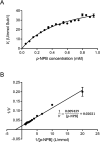Enzymatic Degradation of p-Nitrophenyl Esters, Polyethylene Terephthalate, Cutin, and Suberin by Sub1, a Suberinase Encoded by the Plant Pathogen Streptomyces scabies
- PMID: 32101840
- PMCID: PMC7104285
- DOI: 10.1264/jsme2.ME19086
Enzymatic Degradation of p-Nitrophenyl Esters, Polyethylene Terephthalate, Cutin, and Suberin by Sub1, a Suberinase Encoded by the Plant Pathogen Streptomyces scabies
Abstract
The genome of Streptomyces scabies, the predominant causal agent of potato common scab, encodes a potential cutinase, the protein Sub1, which was previously shown to be specifically induced in the presence of suberin. The sub1 gene was expressed in Escherichia coli and the recombinant protein Sub1 was purified and characterized. The enzyme was shown to be versatile because it hydrolyzes a number of natural and synthetic substrates. Sub1 hydrolyzed p-nitrophenyl esters, with the hydrolysis of those harboring short carbon chains being the most effective. The Vmax and Km values of Sub1 for p-nitrophenyl butyrate were 2.36 mol g-1 min-1 and 5.7 10-4 M, respectively. Sub1 hydrolyzed the recalcitrant polymers cutin and suberin because the release of fatty acids from these substrates was observed following the incubation of the enzyme with these polymers. Furthermore, the hydrolyzing activity of the esterase Sub1 on the synthetic polymer polyethylene terephthalate (PET) was demonstrated by the release of terephthalic acid (TA). Sub1 activity on PET was markedly enhanced by the addition of Triton and was shown to be stable at 37°C for at least 20 d.
Keywords: actinobacteria; common scab; cutinase; esterase; potato.
Figures







Similar articles
-
Detection of potential suberinase-encoding genes in Streptomyces scabiei strains and other actinobacteria.Can J Microbiol. 2013 May;59(5):294-303. doi: 10.1139/cjm-2012-0741. Epub 2013 Feb 27. Can J Microbiol. 2013. PMID: 23647341
-
Enhanced cutinase-catalyzed hydrolysis of polyethylene terephthalate by covalent fusion to hydrophobins.Appl Environ Microbiol. 2015 Jun;81(11):3586-92. doi: 10.1128/AEM.04111-14. Epub 2015 Mar 20. Appl Environ Microbiol. 2015. PMID: 25795674 Free PMC article.
-
Effects of AttM lactonase on the pathogenicity of Streptomyces scabies.Lett Appl Microbiol. 2018 Sep;67(3):270-277. doi: 10.1111/lam.13019. Epub 2018 Jul 17. Lett Appl Microbiol. 2018. PMID: 29897616
-
Virulence mechanisms of plant-pathogenic Streptomyces species: an updated review.Microbiology (Reading). 2019 Oct;165(10):1025-1040. doi: 10.1099/mic.0.000818. Epub 2019 Jun 4. Microbiology (Reading). 2019. PMID: 31162023 Review.
-
[Advances in cutinase research].Sheng Wu Gong Cheng Xue Bao. 2009 Dec;25(12):1829-37. Sheng Wu Gong Cheng Xue Bao. 2009. PMID: 20352957 Review. Chinese.
Cited by
-
Polyester degradation by soil bacteria: identification of conserved BHETase enzymes in Streptomyces.Commun Biol. 2024 Jun 12;7(1):725. doi: 10.1038/s42003-024-06414-z. Commun Biol. 2024. PMID: 38867087 Free PMC article.
-
Review of nomenclature and methods of analysis of polyethylene terephthalic acid hydrolyzing enzymes activity.Biodegradation. 2024 Jul;35(4):341-360. doi: 10.1007/s10532-023-10048-z. Epub 2023 Sep 9. Biodegradation. 2024. PMID: 37688750 Review.
-
Phylogenetic analysis and in-depth characterization of functionally and structurally diverse CE5 cutinases.J Biol Chem. 2021 Nov;297(5):101302. doi: 10.1016/j.jbc.2021.101302. Epub 2021 Oct 13. J Biol Chem. 2021. PMID: 34653507 Free PMC article.
-
Microbial colonization and degradation of marine microplastics in the plastisphere: A review.Front Microbiol. 2023 Feb 17;14:1127308. doi: 10.3389/fmicb.2023.1127308. eCollection 2023. Front Microbiol. 2023. PMID: 36876073 Free PMC article. Review.
-
The application of bioremediation in wastewater treatment plants for microplastics removal: a practical perspective.Bioprocess Biosyst Eng. 2022 Nov;45(11):1865-1878. doi: 10.1007/s00449-022-02793-x. Epub 2022 Sep 29. Bioprocess Biosyst Eng. 2022. PMID: 36173483
References
-
- Beauséjour J., Goyer C., Vachon J., and Beaulieu C. (1999) Production of thaxtomin A by Streptomyces scabies strains in plant extract containing media. Can J Microbiol 45: 764–768.
-
- Beisson F., Li-Beisson Y., and Pollard M. (2012) Solving the puzzles of cutin and suberin polymer biosynthesis. Curr Opin Plant Biol 15: 329–337. - PubMed
-
- Bernards M.A., and Lewis N.G. (1998) The macromolecular aromatic domain in suberized tissue: a changing paradigm. Phytochemistry 47: 915–933. - PubMed
MeSH terms
Substances
Supplementary concepts
LinkOut - more resources
Full Text Sources
Other Literature Sources
Miscellaneous

